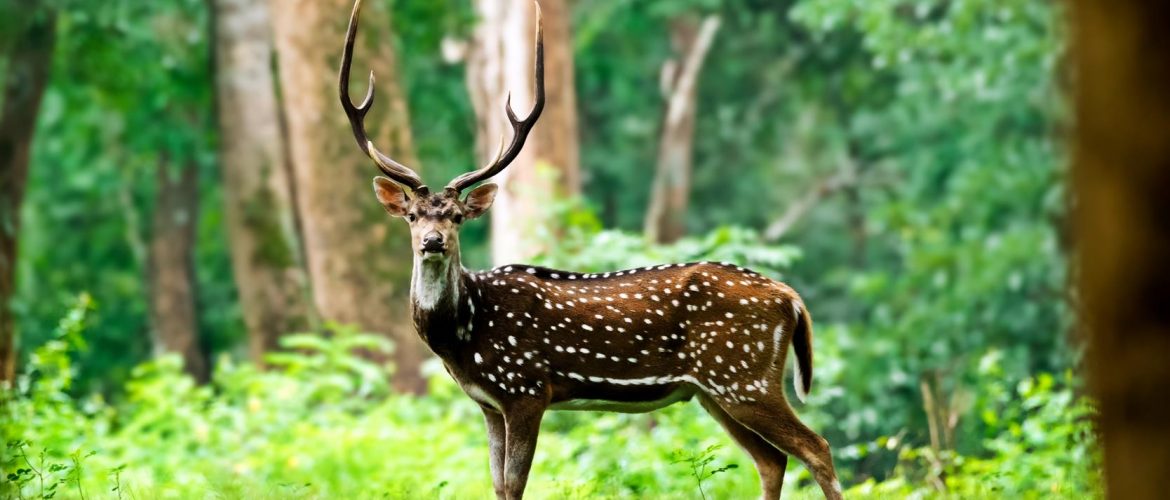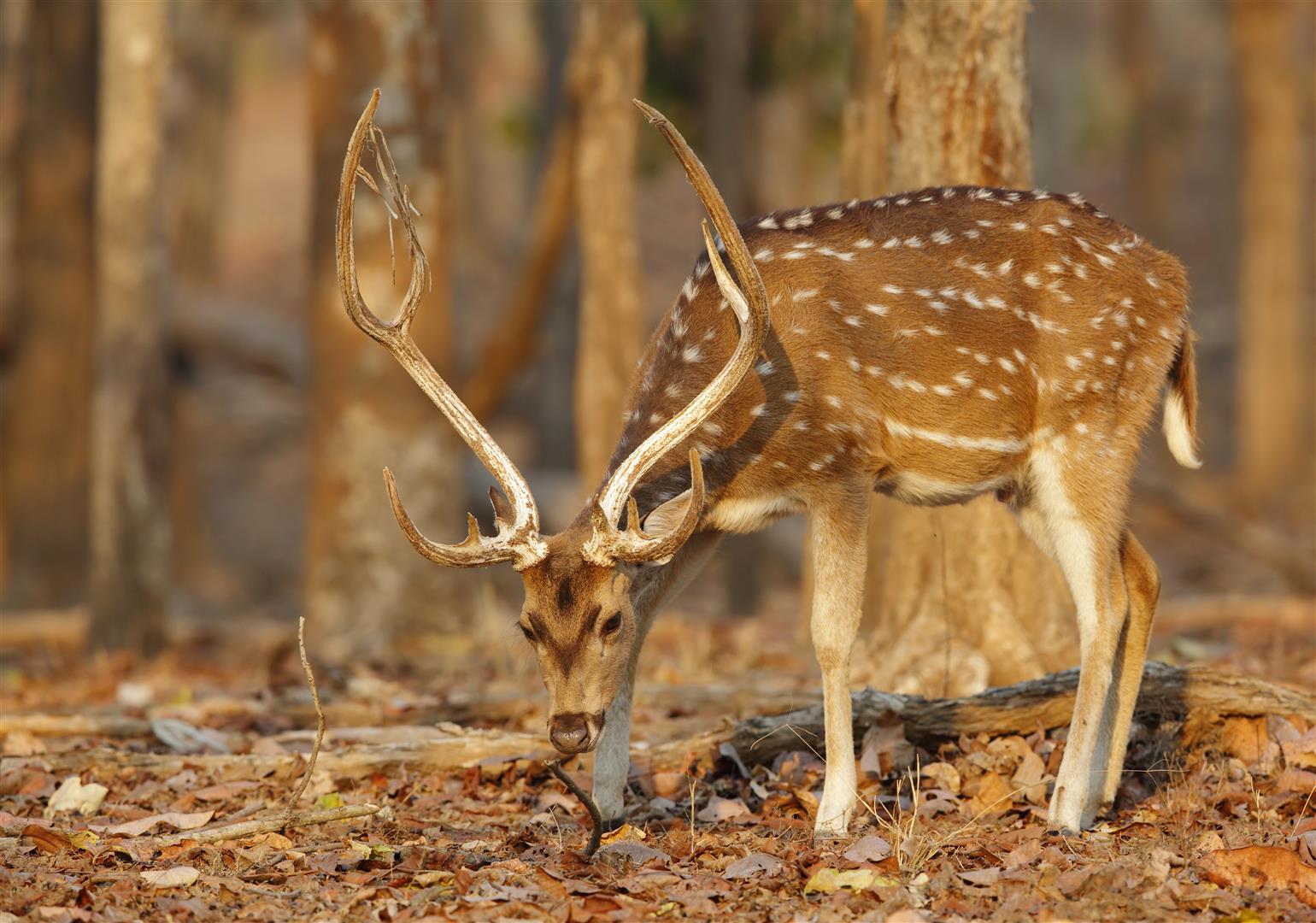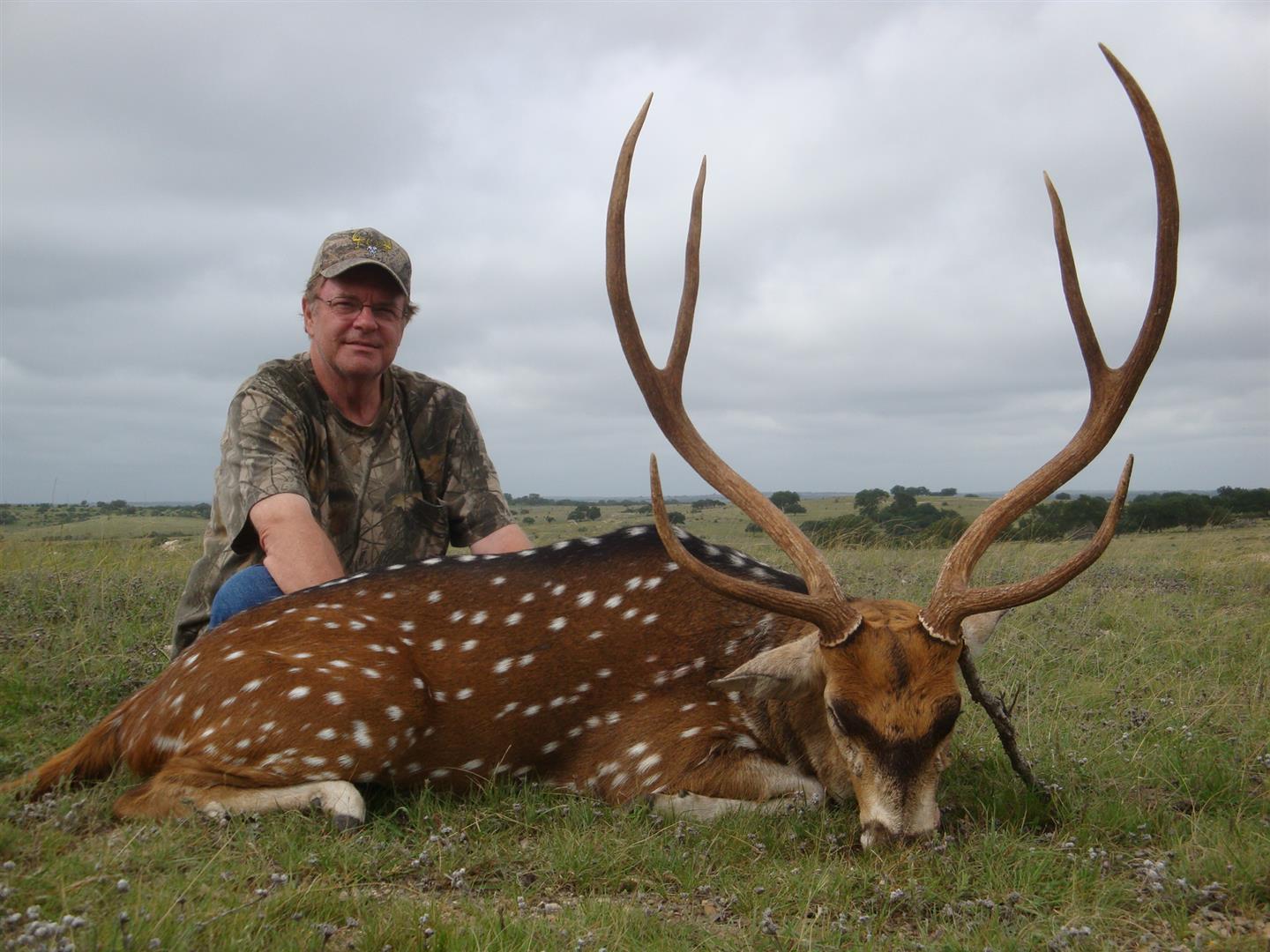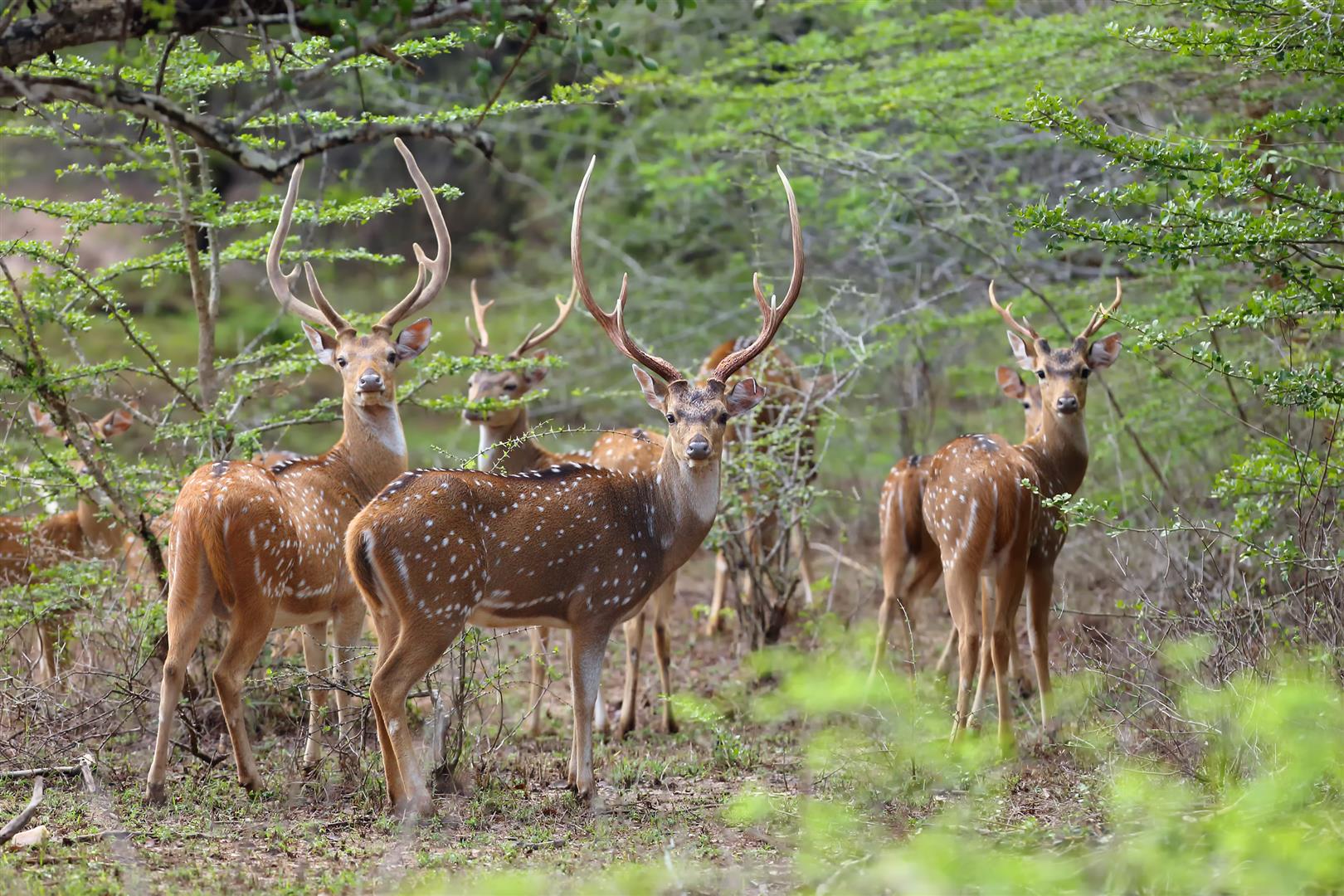$0.00
No products in the cart.

Chital (pronounced Cheetal), also widely known as Axis Deer and Spotted Deer – are regarded by many as the most beautiful deer in the world. They were Australia’s earliest deer import with the first arriving from India in 1803. Native to the Indian subcontinent they are gregarious (with very strong herding instincts) and can be found in small to large herds throughout India and Sri Lanka. They are a smaller to medium-size deer; males can stand approximately 86cm tall at the shoulder (34inches) and weigh approximately 90kg. Females are considerably smaller and weigh approximately 45kg. Bucks grow antlers with typically 3 tines per side. Mature specimens often grow basal snags and upper-tines off brow tines. During suitable seasonal growth in Australia they regularly grow antlers with beam lengths in the higher 20inch bracket. Big ones of 30inches plus may be obtained with exceptional antlers of 32inches plus being taken occasionally. During the past few decades Australia Chital have produced increasingly larger antlers with longer antler lengths reaching the upper 34inch category. India has produced the world’s longest Chital antlers at 41inches. Free ranging Chital in both Croatia and Texas (USA) also produce remarkable trophies. The Vice President of the European Hunting Union informed me a few years ago that Croatia produced the world record Chital but I have not confirmed this. Texas, USA now offers some of the best free range Chital hunting (not all Texas hunting is game ranch). There are vast open range ranches that offer quality free-range, fair chase hunts and trophies to 36inches are available for the lucky hunter. Chital from this area produce absolutely outstanding tine length and Ken Skeels (TAS), who recently hunted there, shot trophies of 33 and 34inches in length, one with 11inch inner tines and exceptional brows.

Chital are a tropical or subtropical species that prefer lowlands and dislike steeper terrain. Their native range is through India from 8-30 deg. N (including Sikkim), Nepal, Bhutan, Bangladesh and Sri Lanka. Eastern Rajasthan forms the western distribution boundary while the northern boundary runs along the Bhabar-terai belt of the foothills of the Himalaya from Uttra Pradesh and Uttaranchal through Nepal, northern West Bengal and Sikkim to western Assam and the forested valleys of Bhutan below 1,100 meters. The eastern boundary runs through western Assam, as distant east as the Dhunsiri River to the Sundarbans of West Bengal and Bangladesh. This encompasses the greater landmass of India. They are protected throughout their native range however illegal hunting and snaring occurs.
Chital have been widely introduced into many countries including Australia, Andaman Islands (India), Argentina, Armenia, Brazil, Croatia (Islands of Brijuni), Moldova, Pakistan, Papua New Guinea, Ukraine, Uruguay, the USA (California, Florida, Hawaiian Islands and Texas). Not all introductions have succeeded for example: some were introduced to west-central Slovenia but failed. They were also introduced with considerable herds established in the vicinity of Bathurst, NSW (said to number about 400 in 1809), Western Victoria (Australia) and New Zealand. Due to their preference for grassland, open woodland, living along creeks and being drawn to crops they are vulnerable to exploitation from hunting pressure and these habits ultimately led to their demise at these locations.
Chital display a common preference both in India and Australia for congregating in open grassland areas near habitation. They require regular water supplies and prefer flat grassland with nearby scrub for shade throughout the day. When conditions deteriorate to drought, when little or insufficient grass is available, Chital disperse and travel to more heavily forested areas where they feed on fallen fruits, leaf litter, and browse. Bark, antler and bone chewing are all common with these and most deer.

Chital deer need to drink water once a day and this requirement dictates their range dispersal. Within the traditional North Queensland Chital range, this over-the-years for me, has provided the opportunity of overlooking large waterholes as a proven ambush hunting technique. When Chital disperse during drought, I believe this may be the most successful way to obtain big trophies. The better hunting periods are when seasonal conditions are good (suitable rains and grass growth) and they congregate on open flats during morning and evening. Good conditions also provide suitable nutrition, one of the requirements for excellent antler growth.
In their native lands they are a significant prey animal for wolves, Bengal tiger, Asiatic Lions, leopards, Indian rock pythons, dholes, Indian pariah dogs and mugger crocodiles while in Australia, Dingoes and Wedge Tailed Eagles prey upon them.
Late last year I photographed Chital in Yala National Park, Sri Lanka where my wife and I completed wildlife safaris over several days. They are totally protected throughout Sri Lanka however when viewing hundreds of deer (actually thousands) the surprising thing to me was the scarcity of big bucks per herd. With no trophy hunting and full protection I expected to see larger numbers of mature large antlered bucks but this wasn’t the case. In fact in Australia the ratio of large trophy animals to population is similar. I sighted a few outstanding bucks with antlers I estimated at 33inches, and one outstanding buck that I couldn’t clearly photograph due to him being in scrubby bush, that fed with his nose on the ground and antlers approximately 10inches over the top of his back. This one surely must have been around 36inches plus. All Chital sighted had fairly ordinary to moderate tine lengths and beam mass, when many of the better Australian trophies I have seen actually have better points. In Yala some single herds numbered approximately 100 deer and on one large flood plain there must have been 1,000 deer. The more common size herds scattered on plains and throughout scrubland, numbered approximately 20 animals.
Although there were several much earlier introductions of Chital to various parts of Australia; the major successful introduction occurred during 1886 when Mr. William Hann a pioneer, explorer and owner of Maryvale Station on the banks of Maryvale Creek (Tributary of the Clarke and Burdekin Rivers) arrived with a Chital hind from Ceylon (Sri Lanka) while returning from England. A short time later another hind and a stag was imported from India by Mr. Hann, with another separate stag shortly after (Bentley 1967). From these four deer Australia’s successful Chital herds survived and flourished. From their meager introduction they multiplied through the regular droughts of the region and constant dingo and eagle depredation. For many years Chital were present on Maryvale and spread downstream along Maryvale Creek to nearby neighboring Niall Station. An additional injection of new blood was introduced considerably after they were well established. The Clarke family (direct descendants of William Hann) established Maryvale as a private sanctuary specifically to protect the Chital. The Queensland Stock Squad was obliged to provide a degree of protection and patrols of the region. This occurred through until 1979 and greatly assisted the deer in obtaining a solid base. There were recorded deer-sightings, where they had wandered, far from their traditional range and some early satellite herds established. They soon spread to neighboring Spring Park and Bluff Downs. This region consists of red basalt tablelands, gravelly granite ridges with a mix of red, chocolate, and black basalt soils. There are ironbark, bloodwood, various gums, lancewood and wattle. The range has numerous native and introduced grasses.

With the advent and development in the 1970s of the Australian deer farming industry and flourishing Chital populations on Niall Station Mr. Mick Anning (the original owner of Niall) built a substantial deer trap directly opposite Niall homestead on the true right bank of Maryvale Creek. Mick was a tough, hard north Queenslander who was entrepreneurial and promptly cashed in on the lucrative deer market. He caught many Chital that provided a steady supply for deer farms throughout the country. During my teenage deer-hunting years I witnessed the traps use and we hunters should be forever grateful to Mick and Niall that ultimately provided Australia its many additional Chital herds. I am aware of reports that one further station also trapped Chital but have no additional knowledge further than that.
With the removal of protection of deer in Queensland during 1979 Mick Anning progressed from trapping deer to offering for the first time in Queensland, legal hunting for trophy Chital bucks. The Australian Deer Association was involved with at least promoting this new hunting opportunity and this provided me, and many others, their first opportunity to hunt Chital. Niall had been subjected to constant trophy hunting pressure that year and when I arrived the deer were extremely alert and required the utmost caution when stalking. My hunting partner and I secured trophies of 27 – 29 inches. Subsequent years I have observed them quite calm and relatively easy to approach, especially following drought periods, when for a couple of years they have been subjected to minimal hunting, if any.
The traditional Queensland and major range is north of Charters Towers where they have now dispersed onto numerous surrounding stations adjacent to Maryvale and Niall. The herds extend southward almost to Charters Towers, southwestward almost to Hughenden and northward just inland approximately half way between Townsville and Cairns. This herd has been estimated to contain approximately 10,000 animals (which in all probability was underestimated) that can fluctuate significantly between good seasons and drought. There are now established pockets around Townsville, Cairns, south of Cooktown, Barcaldine (near Longreach), Winton, Texas (Australia), scattered pockets northwest of Brisbane and westward of Warwick. Several of these and additional isolated herds throughout N.S.W have arisen from deer farm escapees and in some cases translocations.
During the 1990s I commenced guiding on Niall and spent some time with Mick and Maisie Anning at their other station ‘Kangerong’ which is situated on the Basalt River to the south of Maryvale. The Chital were in great populations during this period and although Kangerong had only a small population around the homestead and airstrip it did produce some excellent trophies (32 ½” with great points was one of my clients best). Niall produced similar size heads and it was possible to view maybe a thousand deer a day when they were mobbed-up during great seasonal conditions. One such hunt I observed on Niall, upstream towards Maryvale and on the true right banks of Maryvale Creek, 90 stags in one mob. The best one of these was taken by my Queenslander friend, Brian DeJong (deceased). I guided four hunters and they all shot 30 – 32 ½” trophies within three days. The hunting was truly excellent and with good planning we managed similar takes of quality bucks regularly.
Another time when personally trophy-hunting the region during the 80s my hunting partner and I carefully assessed, and believed at days end, that we had observed around thirty, 30inch-plus-heads, during one days hunting. I secured my extremely heavy 33 ¼” trophy on that day and our tally was four over 30inches for the day. My partner had also lost one that we believed to be 34inches long with all very good points. We restricted ourselves to photographing only, for the remainder of the trip.

During the period of the Gillard Government, Greens filmed Australian live cattle being cruelly mistreated inside Indonesian Abattoirs. This was broadcast firstly on ABC TV then widely on Australian television and caused an instant uproar! In a self-saving rash decision Gillard acted in knee-jerk style and cancelled Australia’s live beef exports to Indonesia (June 2011). This was catastrophic and caused a massive collapse in Australian beef prices. This was so devastating that many ‘Top End’ cattle producers could not survive the extended collapse. The banks moved in quickly and many, many stations throughout QLD and the NT were lost. Kangerong went early. Maryvale that had been in the same family since first settlement (154 years) was lost to the banks. I was about to re-commence guiding on Niall and it sadly was another to go. Beef prices were to recover but it was all too late for many hard working Australians who lost everything. The loss of the two major Chital hunting properties was also devastating to hunters (Maryvale had permitted, safari style guided hunting just several years prior to this).
Recently during July 2017 a group of northern cattle grazers commenced a class action suing the Federal Government for $600 million in compensation for their losses as a result of the live beef export ban. This figure I expect would be the tip-of-the-iceberg when encompassing the wider ramifications!
Combined with this, during 2014 Chital deer were listed under the Biosecurity Act as a ‘Restricted Invasive Animal.’ This new Act details Chital as causing significant environmental damage, stating, “They can damage crops, pastures and forestry plantations and can compete with livestock for pastures. Feral deer can alter the structure and composition of endangered ecological communities, causing erosion and spreading weed seeds. They stray onto roads becoming traffic hazards and may cause motor vehicle accidents in rural and urban areas.”
Humans do as well! It all sounds too familiar.
Biosecurity also states, “Wild deer are susceptible to exotic livestock diseases including foot-and mouth disease, rinderpest, vesicular stomatitis, rabies and blue tongue. If unchecked, wild deer could play a major role in the spread of infection and act as a reservoir if these diseases are introduced to Australia.”
Humans and livestock are susceptible to the same threat but we don’t shoot all of them! The fact is Chital don’t have any of the above listed B.S. but action such as this is what hunters can expect to increasingly experience in the future.
Once an animal is classed Restricted Invasive Animal, by law, it must not be moved, fed, given away, sold, or released into the environment without a permit. The Act requires everyone to take all reasonable and practical steps to minimize the risk associated with invasive plants and animals under their control. This obligation also extends to local governments.
Under the new Act concentrated ‘culling’ commenced almost immediately and a large number of Chital have been removed from approximately 10 properties within the traditional range. Landowners consented to this action; and less deer equated to more available feed for their valuable cattle. Lower numbers of deer also provide relief from constant troublesome poaching. Current, systematical-slaughter of Chital is primarily performed from vehicles by spotlight shooters. Some properties complete their own culling, which enables them to manage their private herds within, to meet their own requirements. It is no surprise that action such as this has occurred and it’s reminiscent of the way Buffalo in the NT were handled during the BETEC destocking program of the 1990s. It’s in hunters best interests when contemplating future hunting to assist wherever possible with culling and lowering wild deer populations.

Although much of the previous information may be alarming to hunters, Chital in the traditional range are well established, numerous, and I believe, able to withstand the culling. Some properties (including some managed by guiding outfits) have remained untouched by ‘cullers’. However hunters planning to visit the area would be wise to choose their destination or guide carefully. Lowering populations is a proven way to increase trophy size as larger volumes of select, preferred graze and brows species become available to the remaining deer – so the news is not all bad. A hunt for one of these beautiful deer within the traditional range is a special and wonderful experience!
To view Chital in Yala, Sri Lanka contact Terrence listed on my Murray Thomas Taxidermy Facebook under Services.
For free range Chital hunting in Texas, USA – Hunter Ross of ‘Desert Safaris’ is a recommended outfitter.